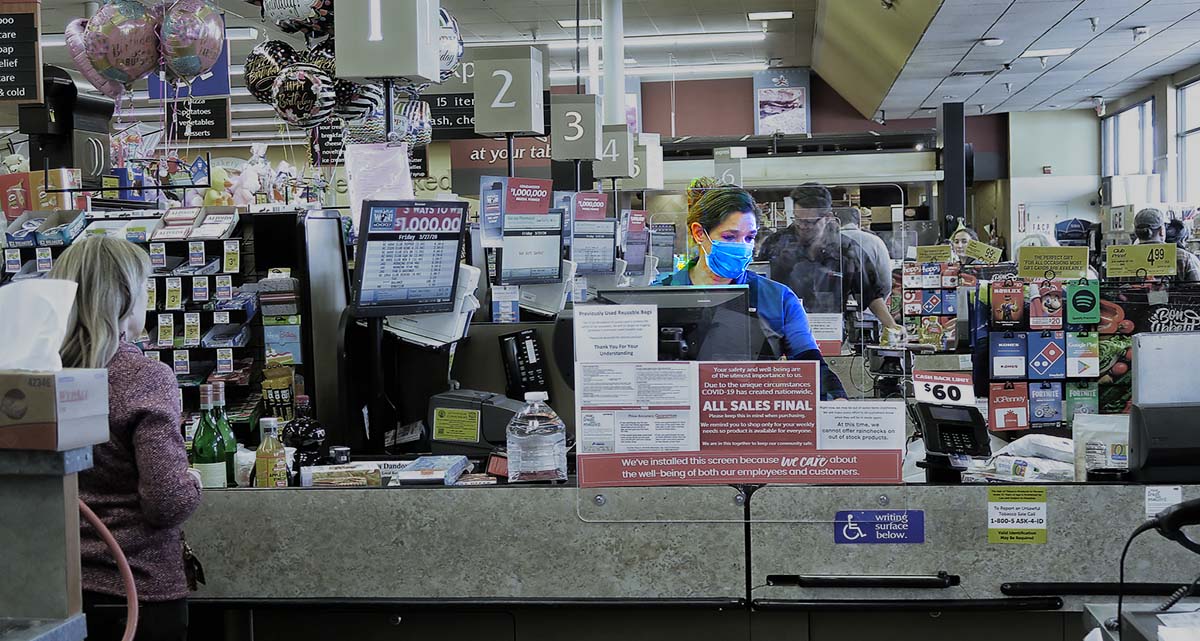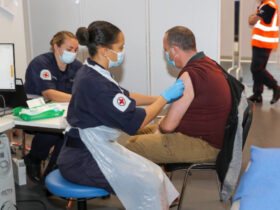The COVID-19 pandemic that spread like wildfire from Wuhan, China will be one of the most defining events of our lifetime. But despite the lethal effects of the virus itself, its most lasting keymark will be the unprecedented and often heavy-handed deployment of massive lockdowns all over the world. By March of 2020, half the world’s population found itself confined at home in an effort to “stop the spread.” Since then, many countries have phased in and out of these lockdowns—foremost among them, the United States.
Amidst the frantic calls by government and media for businesses and people to shut down and self-quarantine, few have taken the time to consider whether the lockdowns have helped or hurt the working class.
A careful consideration of COVID-19’s political economy reveals that the lockdowns did not, in fact, live up to the life-saving promise of their propaganda. Now that the political utility of the lockdowns has waned, it will become increasingly clear that these measures amounted to nothing more than punitive political theater and a further consolidation of capitalist control.
Indeed, the harm done is incalculable.
A “Once-in-a-Century” Pandemic?
At the outset, capitalists and bourgeois scientists expressed fears that the COVID-19 virus was a significant threat to human populations. Bill Gates, writing for the New England Journal of Medicine, observed that the disease was particularly worrisome because, “It can kill healthy adults in addition to elderly people with existing health problems. The data so far suggest that the virus has a case fatality risk around 1%; this rate would make it many times more severe than typical seasonal influenza.”
For working-age adults and their children, COVID-19 had an unremarkable effect on health, when compared to the baseline.
But the science of COVID-19 is constantly changing. Extrapolating a weighted average from current CDC estimates reveals an infection fatality rate (IFR) of 0.65%—around 6-times greater than the seasonal flu. An analysis conducted in the United States excluding institutionalized persons (i.e. nursing home residents) found an IFR of only 0.26%. The WHO published a meta-analysis in October 2020 which calculated an international IFR of 0.23%. Regardless of where the final rate ends up, the main thing to note is the age stratification of COVID-19 lethality. For all those below the age of 70, death rates are similar and or below the seasonal flu. COVID-19 hospitalization rates are similarly stratified by age. In other words, for working-age adults and their children, COVID-19 had an unremarkable effect on health when compared to the baseline.
And yet, fears of a mass die-off were disseminated early on and remain a major talking point for the ruling class and their doctors and scientists. They were quick to present masks as an effective prophylactic against widespread casualties in a stunning about-face. Even at the time of writing, the best available evidence fails to show that masks stop the spread of respiratory viruses of any kind—even in a hospital setting. In the state of California, for instance, cases have skyrocketed during both the first and second waves, in spite of a high reported compliance with mask mandates. In Ontario, Canada, COVID-19 spread rapidly in crowded workplaces, such as long-term care homes, also despite widespread mask usage.
But one need not rely on health data alone to understand that the virus was never an unusual risk to the working class. A grimmer story is told through employment and production data.
Did COVID-19 Impact the Working Class’s Ability to Work?
In response to the dire warnings from big capitalists and much of the scientific community, President Donald Trump declared COVID-19 a national emergency in March of 2020. Within weeks, US unemployment had skyrocketed to 14.8 percent, causing many in the bourgeois media to make histrionic comparisons to the Great Depression.
The restrictions characterizing the lockdowns—on mobility, on businesses, and on indoor capacity—continue to be held responsible for any and all economic damage. However, a closer look at employment statistics tells a different story.
While it is true that individual capitalists in certain sectors and small capital were disproportionately affected by the closures, the employment rate at the sites of productive work rebounded after a short time. Mining and logging went broadly unscathed, as was the utilities sector. Manufacturing and wholesale trade saw a decline slightly less severe than their worse level during the recession of 2008-2009, and quickly rebounded. Construction’s decline came nowhere close to its worse levels during 2008-2009, and also quickly rebounded. The same is true of transportation and warehousing. Retail trade has now nearly recovered back to pre-pandemic levels, despite lockdowns’ effect on small business and shopping centers.
The unemployment rate may have been objectively high at the beginning of the pandemic, but it was disproportionately generated by two sectors: leisure and hospitality, and “other services” (repair and maintenance, personal and laundry services, membership associations and organizations, and so on). These industries’ employment figures dropped by 48 percent and 22 percent, respectively.
But surely the pivot to remote work protected broad numbers of the working class from contracting the disease? Could this explain why productive sectors continued to operate unabated?
There is undeniably an overall decline in the American economy, but it is one that should be better understood as a regular recession.
The Bureau of Labor Statistics estimates that among the 44 percent of workers in the US who hold jobs that can be performed remotely, about 35 percent of them ever did so during the pandemic. Meanwhile, if we use education as a proxy for “the working class,” upwards of 74 percent of those without a college education hold jobs that cannot be performed remotely. The combination of an increase in remote working and strict social distancing measures did indeed mean that fewer individuals were in physical circulation. However, the decrease in human mobility was compensated by an enormous rise in online shopping and delivery services—to the benefit of large firms such as Amazon with the infrastructure to handle it. In other words, the vast majority of workers not only kept their jobs, but have by and large been working uninterrupted since the start of the pandemic.
The insignificance of COVID-19 to the working conditions of the working class is reinforced by the near complete absence of any class struggle. Once masks were propagandized as a preventative measure, some militancy was observed as workers demanded protective equipment. This was promptly provided, and resistance diminished. Education workers—often led by unions—have acted more militantly against returning to work. However, even in that domain resistance has been uneven and, in many places, non-existent.
Did COVID-19 Cause a Recession?
The economy today is below pre-pandemic levels, but it remains far from apocalyptic. By November 2020, and despite the lockdowns, employment was back up, significantly. GDP—which, as of 2008, has been primarily bolstered by cash injections from the federal government—bounced back to 33.1 percent after cratering by 31.4 percent the previous quarter. The fourth quarter of 2020 is predicted to have grown 4.1% (in defiance of the “second wave”). Meanwhile, the national unemployment rate is sitting at a historically unremarkable 6.7 percent.
There is undeniably an overall decline in the American economy, but it is one that should be better understood as a regular recession.
More than ten years have passed since the crash of 2008. By the first quarter of 2020, Gross Domestic Product growth was visibly beginning to falter. Employment rates were worrying, too—they had barely risen from the previous years’ levels, and growth was completely stagnant or shrinking in the months prior to when the lockdowns were imposed. These are all typical indicators of impending crisis. That COVID-19 coincided with the onset of recession was merely coincidence; we had found ourselves at the beginning of a new cycle of what Marx has described as “the tendency of the rate of profit to fall.”
In essence, structural contradictions inherent in capitalism inevitably lead to profitability decreasing even as employment increases. The resultant decline in productivity prompts investors to turn off the spigot of money into productivity-increasing technologies. This, predictably, only serves to amplify the falling rate of profitability. Eventually, individual capitalists are forced to close their doors in large enough numbers to cause massive destruction of existing capital.
But capitalists (who, bereft of a coherent theory of capitalism, do not understand why these crises occur) and their bourgeois representatives have pinned the blame for the situation entirely on the virus and the subsequent lockdown measures against it.
Certain segments of small capital (such as small and local businesses) have indeed suffered tragic closures, and plenty of noise has been made about it. But, rather than limit our analysis to the dramas playing out between individual capitalists, one needs to look at the situation in its totality. From the perspective of the working class, COVID-19 never resulted in a significant material change; many working class people have faced poor health, job precarity, debt, and other such societal ailments for a long time.
Meanwhile, quantitative easing—which engines so much profitability in advanced nations—has continued unabated. A recent speech by Federal Reserve Vice Chairman Richard H. Clarida confirmed that the Fed would continue investing billions per month into the real estate market—an important site of GDP growth in the United States. This cash injection continues to forestall the catastrophic collapse in debt servicing that both triggered and ultimately mitigated the 2008 crash.
While these money dumps may stabilize advanced economies in the short term, capitalism’s contradictions can never be resolved through capitalist actions. With the Fed stating that no change to this policy will occur until “stability” is reached, you could be sure that the bourgeoisie are using the COVID-19/”Pandemic Slump” narrative plus injections of liquidity into the system to boost capitalist confidence and promote investment.
Key to this effort were the two stimulus packages passed earlier in the crisis. Totalling $2.9 trillion, the majority of those funds went not into individual cash assistance checks—as is widely misunderstood—but rather went into a plethora of programs intended to boost business and the market. The one-time stimulus payments of $1200 and $600 were only added in order to ensure that the rental market didn’t crash. Seen this way, the stimulus was a successful effort to reestablish investor confidence and prevent a wave of defaults.
Vaccinations and “Reopening” the Economy.
A dominant feature of the left-liberal reaction to the pandemic has been to call for more draconian lockdown measures. But the lockdowns we did endure were only what capital was able and willing to sacrifice: the social and recreational aspects of life, and our access to healthcare. Deprived of visits from family and friends for months, thousands of elderly people died isolated and alone. Others have had cancer treatments, screenings and surgeries delayed, while many more have suffered worsening mental health. No surprise, then, that more and more studies are finding that there are no meaningful health benefits to be gained from these lockdowns.
The measures taken against the heart of proletarian social relations—the bonds of kinship and friendship—were simply a denial of life outside of work. In other words, lockdown is the dissolution of the few non-market interactions left under capitalism, turning life into a seamless fusion of consumption and work. This will become ever more clear as additional data is gathered, until the sheer scope of damage to our mental and physical wellbeing will be undeniable.
If anything, the massive lockdowns have only aided Capital. The fear and precarity inherent in the rhetoric of “the pandemic slump” has been turned against working people in order to increase their exploitation. Huge increases in productivity have been observed, even as companies have long-ceased investing in productivity-increasing technologies. What this suggests is a rise in what Marx calls “absolute surplus value”—that is, the gains are from extensions of the working day and increases in the intensity of the work being performed.
Over the next few months, rhetoric about a heroic “reopening” of the economy and defeat of the virus through a vaccination program will be used to maintain investor confidence. The employment generated by the recession will increase the rate of profit as our new reserve army of labor is pushed into what will be highly exploitative, precarious jobs.
Believing that the virus was ever a significant threat to working people, or that it could somehow be leveraged against the bourgeoisie to advance a class struggle, was a disgraceful mistake. Left-liberals, by supporting an untested, unproven, and historically unprecedented pandemic response, merely aided the bourgeoisie in worsening the lives of the people they claim to speak for.
The Post-Covid Future.
The immediate future will see the capitalist class return to their long-term strategy of accelerating exploitation—one which has been consistently applied regardless of which party controls Congress or the White House. Just one look at the Biden administration’s incoming economic advisers reveals a selection of political operatives whose record on economic policy betrays a total commitment to neoliberal nostrums.
In fact, recall that 94% of the jobs created under Obama’s watch were part-time, temporary, or part of the “gig economy,”—a feat accomplished by the instrumentalization of the country’s massive reserve of labor created by the 2008 crash. This will likely be the case with the Biden administration as well, strengthened now by the 10 million-plus members of the unemployed. This tendency towards insecure work with little-to-no overtime pay and zero safeguards against flippant layoffs is what has characterized western economies for upwards of 40 years.
The long term aim of global capitalism remains unchanged: reduce the wages of workers down to the lowest level possible. The only shocking thing that will emerge from the pandemic won’t be the lockdowns or any of its attendant drama, but how little it will have changed the makeup of capitalism.









